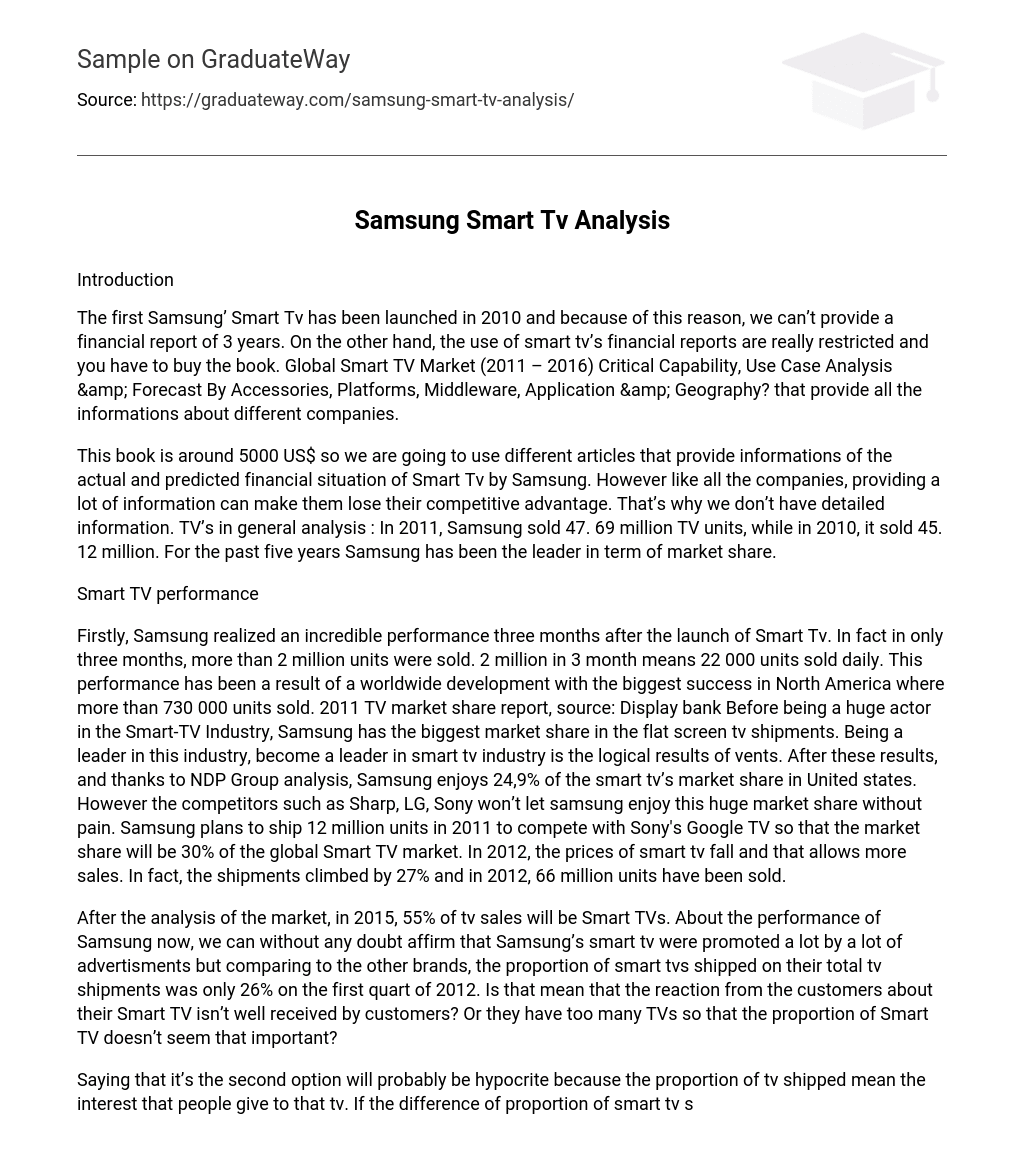Introduction
In 2010, the first Samsung Smart TV was launched, making it impossible to provide a financial report for the past three years. However, the availability of financial reports for smart TVs is limited and requires purchase of a book called “Global Smart TV Market (2011 – 2016) Critical Capability, Use Case Analysis & Forecast By Accessories, Platforms, Middleware, Application & Geography?” which contains information on various companies.
The price of this book is approximately $5000. We will gather data from various articles regarding Samsung’s Smart TVs’ present and expected financial situation. Nonetheless, similar to other companies, Samsung may be reluctant to disclose too much information in order to maintain a competitive edge. Consequently, detailed information may be limited. Regarding total TV sales, Samsung has been the dominant player in the market for the last five years, selling 47.69 million units in 2011 and 45.12 million units in 2010.
Smart TV performance
Samsung’s Smart TV had a remarkable growth rate after its launch, selling over 2 million units in just three months. This translates to an average of about 22,000 units sold per day. The success of the product was mainly driven by international expansion, particularly in North America where sales reached an astonishing 730,000 units. According to Display bank’s report on TV market share in 2011, Samsung had the largest market share for flat screen TV shipments and dominated the Smart-TV industry.
Currently, NDP Group states that Samsung holds a 24.9% market share for smart TVs in the United States. However, Sharp, LG, and Sony are determined competitors seeking to challenge Samsung’s dominance. To counter this competition and further increase their global market share, Samsung plans to ship 12 million units in 2011—aiming to rival Sony’s Google TV—and capture 30% of the worldwide Smart TV market.
In the following year (2012), there was a significant surge in sales due to reduced prices of smart TVs. Shipments increased by an impressive 27%, resulting in a total sale of 66 million units.
Market analysis forecasts that Smart TVs will represent 55% of all TV sales in 2015, but Samsung’s smart TVs only accounted for 26% of smart TV shipments compared to total TV shipments in the first quarter of 2012. This raises concerns about customer reception towards Samsung’s Smart TVs. The presence of non-Smart TVs could also potentially diminish the perceived significance of Smart TVs despite extensive advertising efforts.
Regarding the level of interest in TVs, it would be inaccurate to claim that the second option is hypocritical. If there is a significant difference in the proportion of smart TVs being shipped by two companies, several questions arise. For example, if Sony ships more than 50% of Smart TVs while Samsung only ships 26% of Smart TVs out of total TV shipments, two possibilities emerge: either Sony’s other TVs are not performing well or Sony’s Smart TVs are performing exceptionally well. Unfortunately, due to limited information available within the scope of this project, we cannot provide an answer to this important question.
The analysis conducted by DisplaySearch Smart TV competitors Revenue/profit analysis compares the selling strategy of Samsung and LG in the Smart TV industry. It suggests that if Samsung’s current selling strategy is not as effective as its competitors, the company should identify the cause and find a solution to avoid excessive advertising expenses. In 2012, Samsung achieved $184 billion in smart TV sales with a profit of $1.1 billion, resulting in a profit margin of 0.98%. On the other hand, LG generated $45.22 billion in smart TV sales with a profit of $480.92 million, leading to a profit margin of 1.06%. Sony and Sharp faced significant losses without any profits. With revenue four times higher than LG’s, Samsung demonstrates its dominance in the market despite having only a 13% market share. In terms of profit and overall performance, Samsung outperforms LG, even though it has a slightly smaller profit margin.





